Partner Spotlight: Alice Ovadia, VP of Media Strategy
PUBLISH DATE: 23 April 2025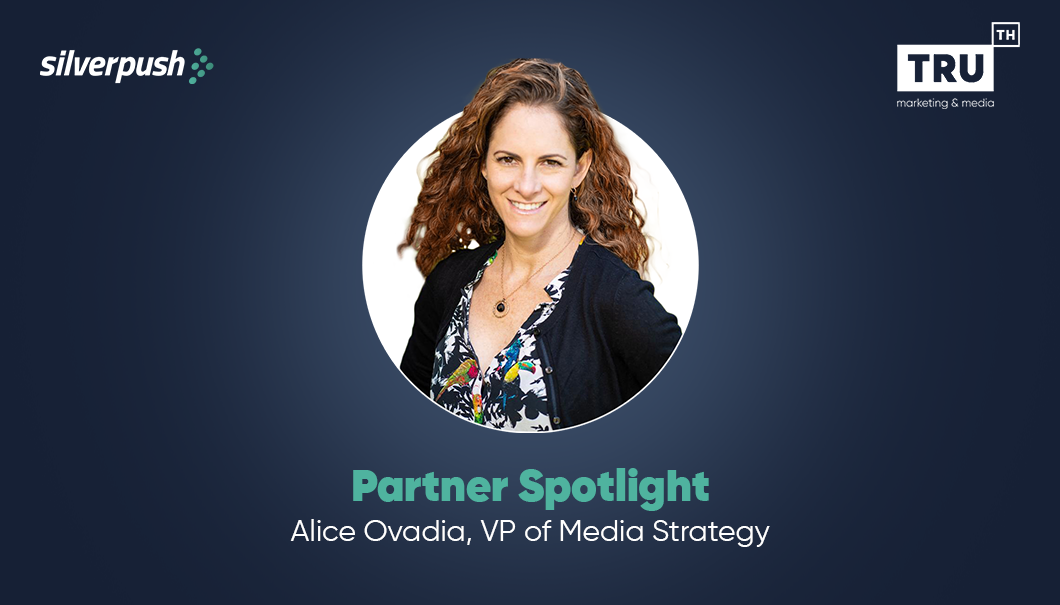
Silverpush is excited to highlight TRUth for our Partner Spotlight this week. We caught up with Alice Ovadia, VP of Media Strategy at TRUth, to learn more about the agency and talked to her about her big predictions for the ad market in the coming years.
Here’s what Alice said.
1. Tell us about the agency. What makes you stand out?
TRUth Media is one of those rare agencies where people stick around. And so do our clients.
Most of our growth comes from referrals, recommendations, and long-standing relationships with clients who take us with them wherever they go. We’re incredibly proud of our retention rate, and it’s all based on the caliber of work that we deliver.
TRUth is set apart by our smart strategy and solid business thinking, but our biggest difference is the culture we’ve carefully built over the years. We treat every employee, no matter what level, like adults and trust them to do good work while maintaining the work-life balance that’s right for them. No one has to choose between being a great parent and a strong professional.
Our name reflects our philosophy of truth and transparency. That’s how we show up in the world, with each other, our clients, and our partners. That simple but powerful principle is the foundation of everything we do.
2. What made you choose Silverpush as a contextual partner?
As the industry continues to move away from cookies, we were looking for a partner that could help us stay ahead without compromising on precision or relevance. Silverpush stood out to us because they’ve really nailed contextual in a smart, scalable way. Their AI-powered tech lets us align our messaging with what people are actually watching and engaging with. We also really value how seriously Silverpush takes brand safety and suitability. At the end of the day, we want to show up in the right places, with the right message, and Silverpush helps us do that in a way that feels both effective and responsible.
3. How has the ad market changed over the past five years? Are there trends in your region that you’ve noticed specifically?
Marketing and media have become increasingly fragmented, with a shift toward digital-first and omnichannel strategies. In the Southwest US, we’ve seen a growing emphasis on multicultural marketing and hyper-local activations as brands work to connect authentically with diverse audiences.
Streaming, retail media, and AI-driven automation have accelerated, reshaping how brands allocate budgets and measure success.
4. What ad channels are driving the best results for clients right now?
Performance-driven digital channels, particularly paid search, social, and programmatic video, continue to deliver strong results.
Retail media networks are also gaining traction as brands look for more direct connections with high-intent shoppers. Additionally, CTV and digital out-of-home (DOOH) are seeing growth as brands seek efficient ways to engage audiences beyond traditional linear TV. In general, we believe that omnichannel plans that include both upper funnel and lower funnel tactics will perform better than those that only include performance channels.
5. Are you noticing any specific trends in how brands are leveraging data or AI-driven tools to connect with local audiences?
Brands are leaning into AI for dynamic creative optimization, predictive analytics, and hyper-local personalization. AI-powered insights are helping advertisers refine audience segmentation and improve real-time bidding efficiency. Additionally, first-party data strategies have become a priority as brands navigate privacy changes while maintaining meaningful customer engagement.
For brands that are not as sophisticated with their internal tools and resources, we help facilitate a lot of this by leveraging tools that offer automation and customization.
6. What are the biggest advertising challenges for brands today? What are the biggest opportunities?
One of the biggest challenges is navigating privacy regulations and signal loss while still delivering measurable performance. Additionally, breaking through ad fatigue and shifting consumer behaviors – not to mention fragmentation – requires us to constantly test, learn, and pivot when needed. On the opportunity side, brands that embrace AI, first-party data strategies, and cross-channel measurement will gain a competitive edge, while those investing in better creative and storytelling and community-driven marketing will build stronger brand affinity.
Want to learn more about TRUth? Visit the agency website here.
Why Granular Insights Are Critical for Ad Campaign Optimization
PUBLISH DATE: 16 April 2025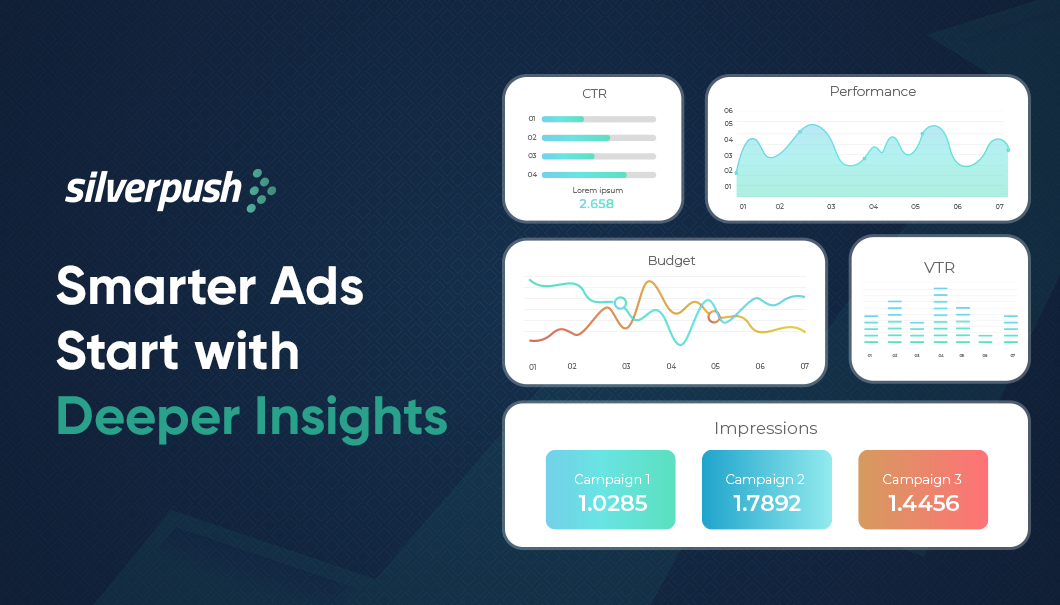
When your ad campaign ends and the dashboard lights up with a “great” VTR or a CTR that’s above average, you celebrate, right? But then comes the pause. What actually made it work? Was it the creative? The audience? The time of day? The context of the video? Most platforms won’t tell you. And that’s where advertising campaigns start falling short.
Today’s digital ecosystem is more fragmented than ever. Users flip between screens, skip ads in seconds, and expect personalization without the creepiness of tracking. With this much unpredictability, you can’t just rely on top-line numbers. You need to zoom in. Granular insights give you the “why” behind performance, not just the “what.” And that makes all the difference.
What Do We Mean by “Granular” Anyway?
Let’s break it down. When we say granular insights, we’re talking about data beyond basic metrics like impressions, reach, or even engagement. It’s knowing which campaign creative drove the most action in a particular context—say, a fashion haul video vs. a skincare tutorial. It’s understanding how your ad performed differently on mobile versus desktop or in urban vs. rural areas.
Granular data means getting answers to questions like:
- Which content categories or video types led to stronger engagement?
- How did creative performance vary across formats, devices, or regions?
- Did contextual alignment—like brand mentions or creator-led content strategy—drive better results?
This kind of detail isn’t just nice to have; it’s your campaign’s biggest growth lever. And it’s what separates a generic campaign from a granular campaign, built to deliver meaningful results.
When You Don’t Have the Details, You Miss the Mark
Honestly speaking, media budgets aren’t getting any lighter. Every dollar has to pull its weight. When you only look at high-level performance, you’re missing what’s under the hood. You might continue running creatives that aren’t actually moving the needle or, worse, waste impressions on contexts that don’t align with your brand.
And legacy platforms? They’re built around audience buckets and keyword lists. Not real context. Not behavior patterns. And certainly not emotion, action, or moment-level engagement.
So, you know your ad worked. But you don’t know why. That’s not optimization—that’s guesswork.
What Granular Insights Help You Unlock?
Let’s look at what you actually stand to gain when you go deeper with your data.
- Creative-context fit: Understand which types of videos, moods, or themes are boosting performance for each creative.
- Audience segment behavior: Break down performance by region, device, or even psychographic patterns.
- Real-time visibility: Know how each creative is performing in different contexts while the campaign is still live.
- Sentiment tracking: Get a pulse on whether viewers are engaging with joy, curiosity, confusion, or even frustration.
With granular targeting, you stop flying blind. Every decision you make is sharper, backed by real behavior and context, not assumptions.
And the payoff is real; according to a recent study, 94% of consumers prefer contextual ads over identity-based ads across the US, UK, and Canada.
What If You Could Actually Act on These Insights in Real Time?
Imagine running a campaign and getting a live snapshot that says, “Your ad is performing 34% better when shown within skincare tutorials at night on mobile.” You don’t wait until the post-campaign report. You optimize right now—tweaking your ad placements, creatives, and budget allocation accordingly.
This is where most platforms fall flat. They’ll give you the numbers but not the story. Not the recommendations. Not the ability to act while it still matters.
That’s the difference between basic campaign analytics and real-time campaign analysis that fuels actual decision-making.
So, How Do You Actually Get These Insights? Enter, Mirrors by Silverpush
If you’re looking for a smarter way to break down your campaign performance, Mirrors was built for this exact purpose. Powered by advanced AI, it employs proprietary machine learning algorithms to analyze and comprehend the digital environment thoroughly. It also helps you identify the most effective moments, contexts, and creative combinations while your campaign is still live.
Here’s what it brings to the table:
- Rich contextual signals spanning multiple content categories and themes.
- Daily insight dashboards that go beyond just clicks and views.
- Performance breakdowns by tactic, creative, geography, device, and platform.
- Creative-context pairing, so you know what to run where.
- Language and emotion recognition across 50+ languages for global relevance.
And when it comes to brand safety, Mirrors goes beyond just being “brand safe.”
Traditional solutions often overblock valuable content or underdeliver on protection. Mirrors offers a comprehensive brand safety & suitability solution built specifically for YouTube environments.
It uses AI-powered content analysis combined with human oversight to ensure your ads appear in suitable, high-quality environments without sacrificing scale.
One retail apparel brand using Mirrors saw an 18% lift from a contextual refresh in Google search. A food brand hit +92% VTR. And a health campaign drove a 5.8% lift in brand recall. These weren’t random results. They were powered by micro-level data that led to smarter decisions.
Final Thoughts: Data is Great, Intelligence is Better
There’s no doubt; granular insights are the difference between an ad that performs okay and one that performs insanely well. The difference between campaigns that just run and campaigns that learn.
And in today’s world of tightening privacy rules, real-time shifts in behavior, and advertising fatigue setting in faster than ever, you need more than averages. You need actionable, granular intelligence.
Mirrors make that possible, turning every ad into an opportunity to learn, adapt, and win.
Want to see how it works in action? Let’s talk.
YouTube CTV Advertising: Bigger Screens, Bigger Impact
PUBLISH DATE: 26 March 2025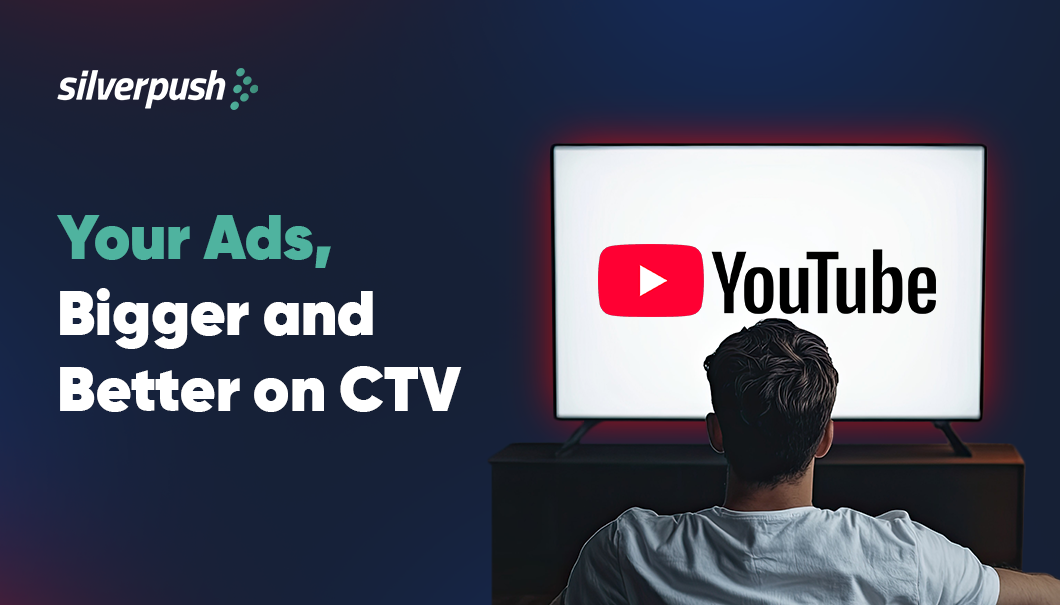
YouTube has always been a powerhouse for brands looking to connect with audiences. With over 2 billion monthly active users, it’s a platform that reaches people everywhere, on their phones, tablets, and laptops.
However, the way people watch YouTube today is very different from how it used to be in the past. It’s no longer just about quick scrolls on a smartphone or catching up on videos during a lunch break. More and more viewers are tuning in from their living rooms, watching videos on the biggest screen in the house.
This shift is what’s driving the rise of YouTube Connected TV (CTV), with an estimated 170 million monthly users in the US. It has officially overtaken traditional platforms like Netflix and Hulu in streaming watch time.
As an advertiser, you can’t ignore this. Why? Because it offers a premium, lean-back experience—one where audiences are fully engaged and paying attention, just like traditional TV, but with all the benefits of digital.
In this blog, we’ll discuss why YT CTV is growing so fast, how it’s shaking up the ad world, and, most importantly, how your brand can make the most of it.
Why is YouTube CTV a Must for Advertisers?
Here’s what you get with YouTube CTV advertising:
1. Massive Reach
YouTube accounts for 11.1% of all TV screen traffic, surpassing Netflix, Hulu, and Prime Video. It’s also one of the biggest co-viewing platforms, with 26% of YouTube CTV watch time happening in group settings. That means one ad placement can reach multiple viewers at once, amplifying your brand exposure.
2. People actually pay attention
When someone watches a YouTube video on their phone, there’s a good chance they’re multitasking, scrolling, texting, or half-watching. But on a big screen? They’re locked in. That means your ads get more attention, better recall, and higher engagement. Let’s take a look at some numbers:
- 80% of YT CTV viewers in the U.S. watch ad-supported content.
- CTV ads drive better engagement. Studies show that YouTube CTV ads deliver a 10% greater lift in recall than ads on linear TV.
- YouTube view-through rates usually fall between 50% and 60%, while CTV can reach up to 96% video completion.
3. Smarter targeting, no creepy tracking
With privacy concerns on the rise, relying on third-party cookies is a thing of the past. YouTube CTV lets you serve ads based on content, interests, and real viewing behavior without invading anyone’s privacy.
4. A smooth, cross-screen experience
Ever notice how you might see an ad on your phone, then later on your TV, and suddenly it’s stuck in your head? That’s the power of YouTube’s ecosystem. Your brand can seamlessly reach people across devices, reinforcing your message without being intrusive.
5. Big-screen impact without big TV costs
Traditional TV ads come with a hefty price tag, and let’s be honest, a lot of those impressions go to waste. With YouTube CTV, you get the same high-quality exposure but with better targeting, real-time performance tracking, and the ability to tweak your campaign as you go.
How Brands Can Incorporate CTV Advertising into Their YouTube Media Mix?
So, you’ve seen how YouTube CTV ads can grab attention and boost brand awareness. Now, it’s time to turn that awareness into real action, whether that’s driving purchases, increasing sign-ups, or deepening engagement with your brand.
Here’s how you can seamlessly integrate CTV into your YouTube ad strategy and convert viewers into customers:
1. Use Cross-Device Targeting to Keep Viewers Engaged
People don’t just watch on one screen. They move from CTV to mobile to desktop throughout the day. Use CTV ads to build brand awareness, then retarget those viewers on their phones or laptops with action-driven ads that encourage clicks and conversions.
2. Optimize Creative for the Big Screen
CTV ads run on large, high-definition screens, so visuals and messaging need to match that premium experience. High-quality visuals, clear branding, and engaging storytelling work best because viewers are usually in a relaxed, entertainment-focused mode rather than actively scrolling.
3. Use AI-powered Contextual Targeting to Reach the Right Audience
Instead of guessing where your ads should go, use AI-driven contextual targeting to align your message with relevant content. This ensures your ads reach the right audience at the right moment, whether they’re watching a sci-fi movie or exploring tech-related content.
4. Measure Performance with CTV-Specific Metrics
Traditional click-through rates (CTR) don’t fully capture the impact of CTV ads since viewers can’t always click as they would on mobile. Instead, focus on view-through rates (VTR), brand lift studies, and incremental reach to measure awareness and engagement more accurately.
5. Align Messaging with Viewer Behavior
Since CTV viewers tend to have longer watch sessions, mid-roll and post-roll ads can be more effective than shorter, skippable pre-roll ads. Structuring your campaigns to fit viewer habits helps increase engagement and recall without disrupting their experience.
How Mirrors Contextual Intelligence Enhance YouTube CTV Targeting?
When it comes to YouTube-connected TV advertising, precision is everything. It’s not just about getting your ad in front of an audience; it’s about making sure it appears in the right context at the right moment for maximum impact. That’s where Mirrors AI by Silverpush comes in.
With over 12 years of experience in contextual advertising and 10,000+ successful campaigns for global brands, Mirrors AI takes YouTube targeting on CTV to the next level. Unlike traditional targeting methods that rely on broad categories or keywords, Mirrors uses advanced AI to analyze video and even viewer interactions.
💡 So, what does that mean for advertisers?
- Your ads land in emotionally and contextually relevant content, making them feel more natural and engaging.
- Brand safety is a given—no more worrying about ads showing up in the wrong places.
- Ad recall and audience connection skyrocket because your message aligns seamlessly with what viewers are already engaged with.
But it’s not just about placement. Mirrors AI provides real-time insights into contextual performance, audience engagement, and brand suitability, helping advertisers fine-tune their strategies and drive better results.
The Future of YouTube-Connected TV Advertising
YouTube CTV is blurring the lines between traditional TV and digital advertising, creating a space where audiences are spending more time and where advertisers need to be.
You can’t just reuse standard digital ads and expect results. To truly stand out, you need to think contextually.
The brands that embrace AI, precision targeting, and seamless storytelling will be the ones that win. Ads that feel natural, relevant, and well-placed don’t just grab attention; they drive action.
As YouTube continues to dominate the CTV space, the smartest advertisers are already adapting. The question is: Are you ready to make the most of YouTube CTV?
Silverpush Unveils Pre-Bid Brand Safety and Contextual CTV Segments
PUBLISH DATE: 21 March 2025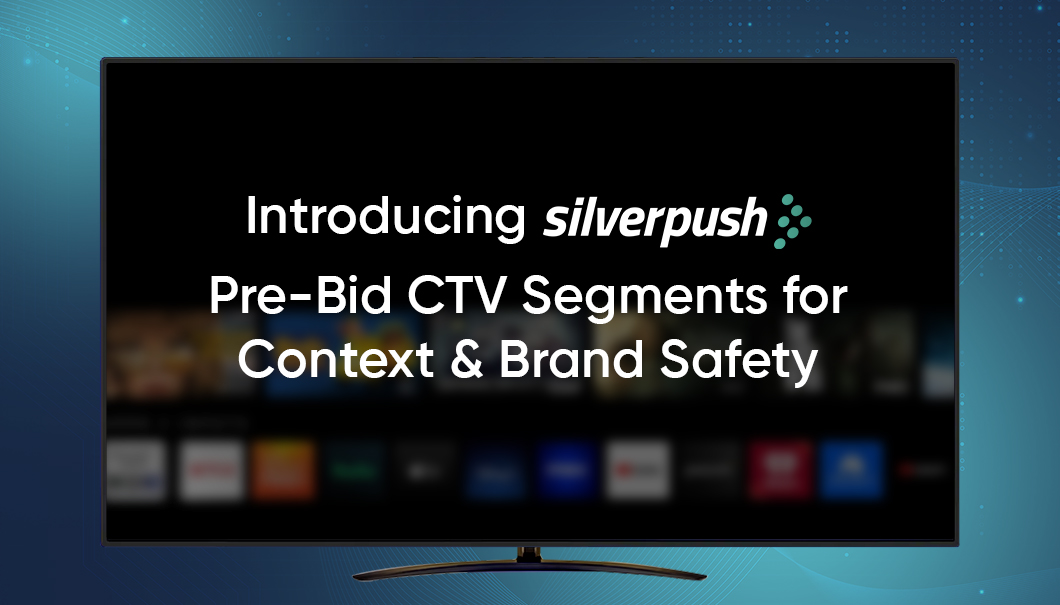
The CTV ad market is booming: global CTV ad spending is estimated to reach $30 billion this year and more than 80% of US households are using CTV devices. The biggest channel for CTV streaming is YouTube, followed by Netflix and Hulu. Completion rates for ads are high and an increasing number of ad-supported channels and apps allow advertisers to segment and run campaigns based on first-party data from CTV platforms.
There’s one catch: with so many channels and so many shows, 80% of advertisers are concerned about where their ads end up running on CTV environments. You can’t always be sure that your ads are going to be brand-safe or relevant to the content.
Especially if the channel runs a lot of potentially risky shows in the first place. Brands and agencies often decide to cut entire apps or channels from their CTV media plan. But this sacrifices engagement and reach at the price of brand safety.
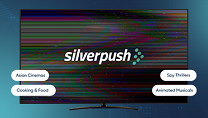
Learn about Silverpush Pre-Bid CTV Segments For Episode-Level Targeting
That’s why Silverpush is thrilled to announce that we are releasing a unique, first-to-market solution for CTV advertisers worldwide that is now available on some of the biggest DSPs in the market.
Silverpush Pre-Bid Brand Safety and Contextual CTV Segments target CTV inventory at the episode level. The segments are pre-bid, so you can make sure your campaigns are running only in highly relevant, brand-safe environments before a single impression is served. You can get started just by logging into your go-to DSP and choosing Silverpush Pre-Bid CTV Segments where available.
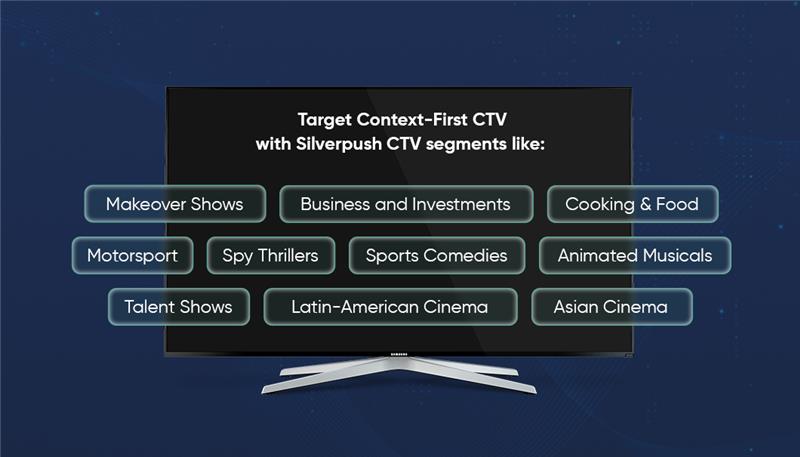
Silverpush Pre-Bid Brand Safety & Contextual CTV Segments have three key benefits for CTV buyers:
- Easy to Test: Select from 50+ pre-built custom contextual segments to easily filter the CTV inventory that’s best for your brand, your campaign, and your audience.
- Episode-Level Targeting: Target at the episode-level to drive higher reach and higher efficiency, ensuring that you’re not leaving valuable channels and apps behind.
- Pre-Bid Segments for Brand Safety & Context: Create custom contextual segments to ensure all your ad placements are brand-suitable and in-context with advanced brand safety filters.
Whether you’re a CPG brand looking to target cooking segments, a finance firm that wants to build a campaign around specific news, or an automaker looking to reach motorsport fans, Silverpush Contextual CTV Segments combine our award-winning Mirrors AI technology with the programmatic power, scale, and precision of select DSPs.
The best part? Agencies and brands can get started right away. Just search and select Silverpush from your media buying platform like any other pre-bid filter to get started with episode-level CTV targeting.
Brand Safety in Online Advertising: A Guide to Protecting Your Brand in 2025
PUBLISH DATE: 21 March 2025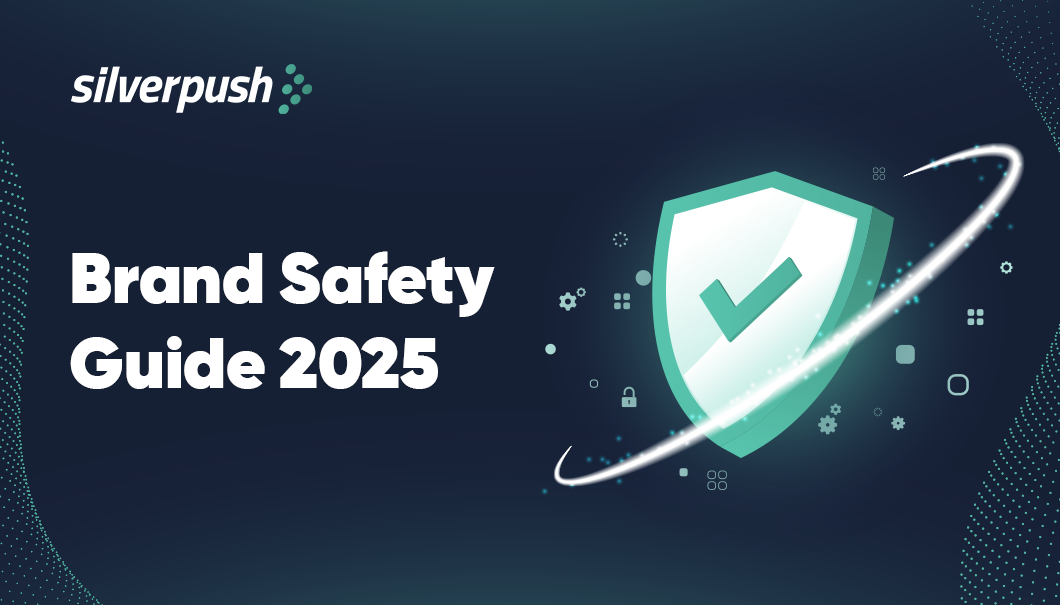
No advertiser wants to see their ad next to fake news, conspiracy theories, or harmful content. But with programmatic advertising automating placements, keeping control isn’t as easy as it used to be.
Maybe you’ve seen it happen—your ad showing up on a questionable website, before a controversial video, or beside content that makes you cringe. With automation running the show, it’s happening more than you think.
Here’s a reality check: 75% of companies say brand safety impacts their business, yet only 26% take action. That means most brands are gambling with their reputation without even realizing it.
So, how do you stay brand-safe while still reaching the right audience? This guide breaks it down. We’ll dive into brand safety risks, real-world mistakes, and the strategies you need to take control—before your reputation is on the line.
Where It All Began… A Brand Safety Crisis
The first major brand safety crisis occurred in March 2017. The Guardian, a British daily newspaper, blacklisted YouTube after discovering its advertisements appearing alongside hate speech and extremist content.
As a result, major names like Toyota, P&G, AT&T, and Verizon withdrew millions of dollars in ad spending from YouTube.
For the first time, YouTube was dealing with both reputation and revenue damage. And it wouldn’t be the last time. Despite implementing remedial steps in 2017, 2018, and 2019, YouTube was still on the radar for deploying ads on harmful content.
YouTube is not the only platform affected by the problem; advertisers on Facebook and Twitter are also experiencing brand safety difficulties.
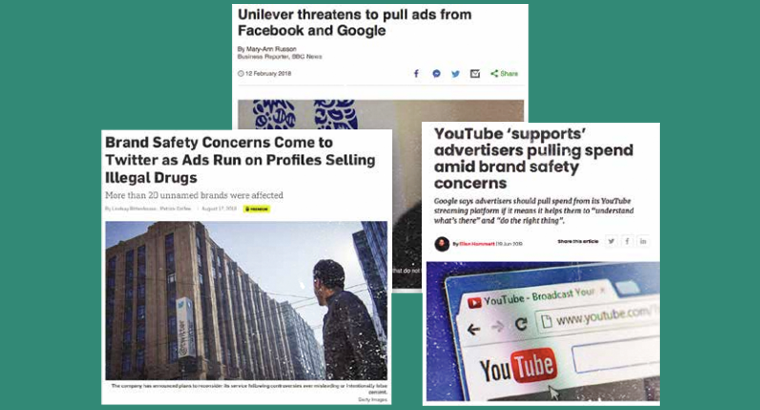
What Is Brand Safety Exactly?
According to the Internet Advertising Bureau (IAB), brand safety is defined as keeping your brand protected in the digital advertising space by ensuring your ads don’t run alongside harmful, offensive, or inappropriate content. That could mean anything from misinformation and hate speech to violent or adult content—things that can make customers question your brand’s values.
But here’s the thing: brand safety isn’t the same for every business. As the IAB puts it, “Brand safety is in the eye of the beholder.” A fitness brand might not want its ads next to unhealthy diet content, while a gaming brand might be fine advertising on edgy entertainment sites. That’s where brand suitability comes in—it’s not just about avoiding bad content but also making sure your ads show up in the right places.
To help advertisers, the IAB created the ‘Dirty Dozen’ list, a set of high-risk content categories to avoid. Ignoring brand safety can lead to negative press, lost revenue, and wasted budgets.

Brand Safety vs. Brand Suitability: What’s the Difference?
Brand safety and brand suitability might sound alike, but they’re actually two different things.
Brand safety is all about avoiding risks—keeping your ads away from harmful, offensive, or controversial content. It’s a broad, industry-wide approach that helps advertisers steer clear of the bad stuff.
Brand suitability, on the other hand, is more about strategy. It’s not just about where your ads shouldn’t be—it’s about where they should be. It ensures your ads show up in places that make sense for your brand and resonate with your audience. What’s a great fit for one brand might not work for another, and that’s the whole point.
The following table breaks down the key differences between the two:-
| Aspect | Brand Safety | Brand Suitability |
| Definition | Protects against negative associations | Promotes positive associations |
| Focus | Avoiding harmful or inappropriate content | Ensuring appropriate and beneficial content |
| Applicability | General across all brands | Specific to each brand’s identity |
| Techniques Used | Keyword blocking, URL exclusion | Contextual analysis, audience targeting |
| Complexity | More straightforward | Requires nuanced understanding of context |
The Challenges of Brand Safety
Brand safety is more complex than just avoiding harmful content—it’s about ensuring your ads appear in the right places without sacrificing reach, engagement, or credibility. With 56% of US digital media professionals considering programmatic advertising vulnerable to brand risk, it’s clear that advertisers face significant challenges in keeping their campaigns safe.
The Scale of Online Content & Malgorithms
One of the biggest hurdles is the sheer volume of content being created. With 500 hours of video uploaded to YouTube every minute, manually reviewing and filtering placements are impossible. Advertisers rely on automation and AI, but these tools sometimes fail, leading to misaligned ad placements or “malgorithms”—when an ad’s context doesn’t match the content. A simple example? A cheerful travel ad appears next to a tragic news article.
Fake News & Misinformation
Another major challenge is fake news and misinformation. If you’re not monitoring where your ads appear, they could end up funding false narratives, conspiracy theories, or clickbait sites designed to mislead. Platforms like Reddit and Google’s AdSense have taken action, but brands must be proactive in avoiding association with harmful content.
Two-thirds of consumers believe brands have full control over where their ads appear, and 77% say seeing ads next to offensive content damages their perception of the brand—which makes brand safety a business-critical issue.
Ads appearing on Extremist Content
Then there’s the risk of extremist content. The last thing any brand wants is to be linked to hate speech, radical views, or offensive ideologies. Yet studies show that brands in the UK unknowingly contributed over £250,000 to extremist websites through ad placements. Social media and programmatic networks make it easier for these mistakes to happen, and once they do, the damage is already done.
Fraudulent traffic is another growing concern. Bad bots account for nearly 28% of all online traffic, inflating ad impressions and draining ad budgets without reaching real consumers. While bot detection tools are improving, advertisers must actively monitor campaign performance to spot irregularities.
There is a need for a smarter, more adaptable approach to brand safety. Instead of relying on outdated keyword blocking and blacklists that often overblock or underprotect, advertisers need AI-powered contextual targeting, human oversight, and real-time monitoring. Content alignment has been shown to increase ad recall by up to 50%, proving that brand safety and campaign effectiveness can go hand in hand.
Why Brand Safety Matters More Than Ever For Advertisers?
Building a brand takes years of effort, but one wrong ad placement can undo all that hard work in seconds. Consumers don’t just connect with your product or service, they connect with your values. If your ad appears next to harmful, misleading, or inappropriate content, it can damage your brand reputation and break consumer trust. In fact, 51% of consumers say they would stop using a brand if its ad appeared near inappropriate content. That means brand safety is not optional; it is essential.
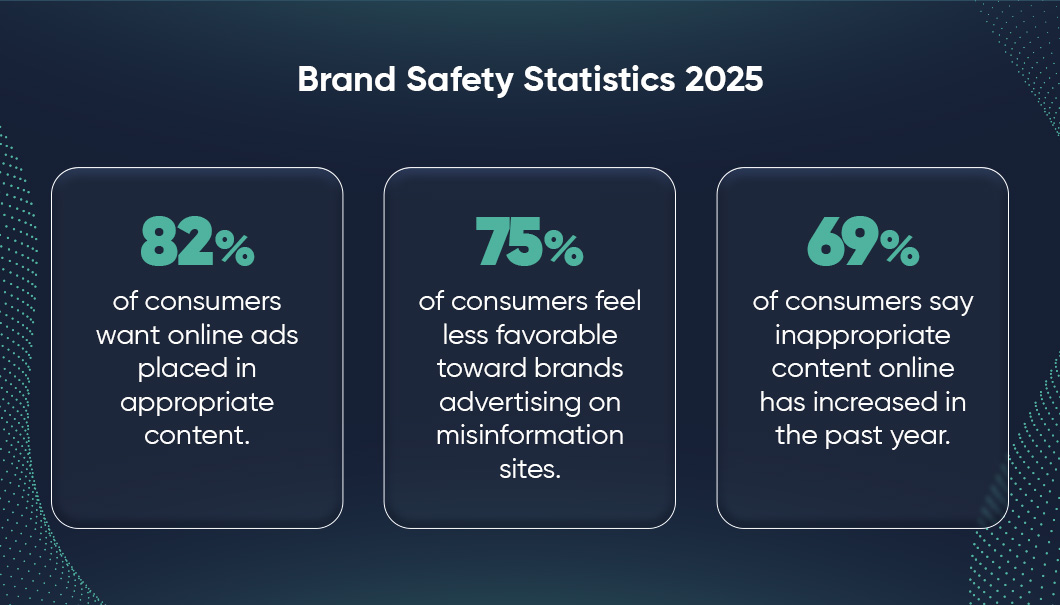
First, it protects your reputation. Around 80% of consumers say they will stop or reduce buying products if they see ads next to violent or extreme content. Where your ad appears shapes how people see your brand. For example, an ad placed alongside disaster footage or negative news could unintentionally create a bad association for your brand.
Second, it keeps you competitive. Today’s consumers expect brands to stand for something. Aligning with positive, relevant content helps reinforce your brand identity and connect with the right audience.
Lastly, it optimizes your ad spend. Brand-safe ads are more likely to appear on premium, high-quality content, ensuring that your budget goes toward real engagement, not wasted impressions.
Brand safety is not just about avoiding risks. It is about building trust and long-term success.
Who Decides “What’s Safe & Unsafe” Anyways?
Many organizations are working to improve brand safety, but two of the biggest names leading the charge are the Interactive Advertising Bureau (IAB) and the Media Rating Council (MRC). These groups, along with brand safety vendors, set the rules and best practices that help advertisers, agencies, and publishers keep ads away from unsafe content.
They make sure publishers follow privacy guidelines and place ads responsibly, while advertisers stick to brand authenticity standards. In short, they help create a safer, more trustworthy ad space, so brands can advertise with confidence and audiences can engage without distractions.
Ensuring Complete Brand Safety with Silvepush’s Mirrors
One of the key challenges with traditional brand safety tools is the inability to identify the right context, be it keyword targeting, blacklists, or dealing with unsafe programmatic video ad placements.
Mirrors, by Silverpush, is an AI-powered contextual targeting solution focusing on serving personalized ads to the audience in a complete brand-safe environment. It enables the processing of large volumes of data at speed, with better context identification, at a larger scale, and improved targeting efficiency.
But brand safety isn’t just about avoiding bad content—it’s about smart placement. Mirrors lets you customize inclusion and exclusion lists, helping you target content that’s not just safe but suitable.
Whether you need to categorize kids’ content, filter specific themes, or refine placements, Mirrors puts brands back in control.
With AI-powered precision, full transparency, and real-time insights, Mirrors ensures your brand is seen where it makes the most impact—without the guesswork.
Ready to take control of your ad placements? Contact us today to book a free demo.
Contextual Intelligence 101: The Future of Smart Advertising
PUBLISH DATE: 11 March 2025
The online advertising landscape is changing at a breakneck pace. Privacy regulations are getting tougher, and third-party cookies are already on their way out. That means advertisers must rethink the way they connect with audiences.
For years, behavioral targeting has been the go-to method for ad targeting. But it’s becoming less and less reliable. And in some cases, it’s even becoming obsolete. So, where does that leave advertisers looking to connect with the right audience at the right moment?
This is where contextual intelligence steps in. Unlike basic contextual targeting, it goes even deeper. Contextual Intelligence uses AI-powered analysis to truly understand content, intent, and user engagement. Instead of guessing based on a few words, it figures out the full context of what someone is watching, reading, or interacting with.
In this article, we’ll break it all down—what contextual intelligence is, why you should care, and how it’s revolutionizing the future of advertising.
So, What is Contextual Intelligence, Exactly?
Think of contextual intelligence as AI with common sense. It doesn’t just spot keywords; it understands what they actually mean in context—whether in text, images, or videos.
For example, if an AI sees the word “shot,” does it refer to basketball, photography, or something harmful? Contextual intelligence figures that out by analyzing the surrounding content, tone, and meaning.
It works by combining machine learning, semantic analysis, and AI-driven pattern recognition to make sense of digital content the way a human would.
Why Context Matters More Than Ever?
Think about the last time you made a quick decision and later realized you had missed an important detail. Maybe you replied to a message without reading the full conversation or picked a restaurant based only on its name, only to find out it wasn’t what you expected. Context changes everything—it adds meaning, perspective, and depth to our choices.
The same holds true in advertising. The where, when, and how an ad appears matters just as much as the message itself. With consumers juggling multiple screens and privacy concerns at an all-time high, advertisers need a smarter, more context-aware approach.
Consider these shifts in digital advertising:-
- Strict privacy guidelines are limiting behavioral tracking. Advertisers can no longer rely on personal data for targeting.
- 80% of consumers say they would reduce or stop purchasing from brands that advertise in unsafe environments.
- 69% of consumers are more likely to engage with ads that match the content they are consuming. Contextually relevant ads don’t just feel better; they perform better.
It’s for these very reasons that brands are moving toward contextual intelligence, a smarter way to place ads without tracking users or risking brand safety.
Let’s take a real-world example of how contextual intelligence helped a brand increase engagement and brand trust.
[Case Study] How Contextual Intelligence Drove 2.5x CTR for Stresstabs
Stresstabs, a wellness brand targeting beauty-conscious Millennials and Gen Z in the Philippines, struggled to grab people’s attention. Traditional YouTube ads weren’t working, as most users hit “skip” within seconds.
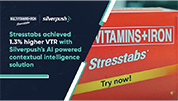
How Contextual Intelligence Helps Stresstabs Drive Higher Ad Engagement
To change that, Stresstabs partnered with Silverpush and used Mirrors, an AI-powered contextual intelligence solution. Instead of placing ads randomly, the AI pinpointed the perfect moments within beauty and wellness content. The campaign then strategically placed Stresstabs’ ads alongside influencers and beauty creators, ensuring the brand message felt organic and engaging.
The result? 1.3x higher VTR, a 2.5x increase in CTR, and a notable lift in brand awareness and favorability. Stresstabs proved that context matters, and when brands place ads where audiences are already engaged, the impact is real.
Introducing Mirrors Contextual Intelligence Solution for Smarter YouTube Targeting
With over 12 years of experience in contextual advertising and a track record of delivering successful results for 10,000+ campaigns for global brands, Silverpush’s award-winning contextual intelligence AI solution, Mirrors, is designed to help brands and agencies precisely reach the right audience at the right moment.
Built for hyper-precision, Mirrors AI takes YouTube targeting to the next level. It helps brands craft brand-safe, contextually relevant media strategies tailored to their specific campaign needs. Instead of relying on YouTube’s broad, off-the-shelf targeting options, Mirrors enables advertisers to drive higher views, better efficiency, and stronger engagement.
But precision isn’t just about placement; it’s also about real-time intelligence. Mirrors provide deep insights into contextual performance, audience engagement, and brand suitability, allowing brands to fine-tune their strategies with confidence. Powered by advanced AI, it ensures that every ad appears in a highly relevant, brand-safe environment, helping advertisers stay ahead in a rapidly evolving digital landscape.
Key Benefits of Contextual Intelligence for Advertisers
Contextual intelligence offers advertisers several key advantages, including enhanced targeting and engagement capabilities. Below are a few of the primary benefits:
1. Increased Engagement and Conversion Rates
Contextually relevant ads can increase user engagement by up to 4 to 10 times. A study by SearchEngineLand found that these ads stimulate 43% more neural engagement and are 10% more engaging than the content itself. This higher engagement translates into better conversion rates, making contextual targeting a powerful tool for boosting performance.
2. Cost Efficiency
With 41% of ad spend often going to waste, targeting the right audience at the right time is crucial. Contextual intelligence optimizes ad spend by ensuring precise targeting, leading to a better return on investment (ROI).
3. Enhanced Brand Loyalty and Trust
79% of consumers prefer contextual ads over behavioral ads, as they complement the content experience without intruding. This trust, particularly strong among users aged 35 to 44, strengthens brand loyalty and reinforces the connection between the brand and its audience.
Wrapping Up
Contextual intelligence is changing the way digital ads connect with audiences. It helps you reach the right people, at the right moment, in the right environment, without relying on personal data. But as privacy regulations evolve, staying informed and adapting your strategy is key.
To make the most of contextual intelligence, you need real-time adaptability, smarter targeting, and content-aware placements that feel natural, not forced. The future of advertising is all about relevance, trust, and smarter ad experiences.
If you want to stay ahead, embracing contextual intelligence isn’t just an option—it’s a must.
Silverpush Celebrates the Women Powering Ad Tech This International Women’s Day
PUBLISH DATE: 07 March 2025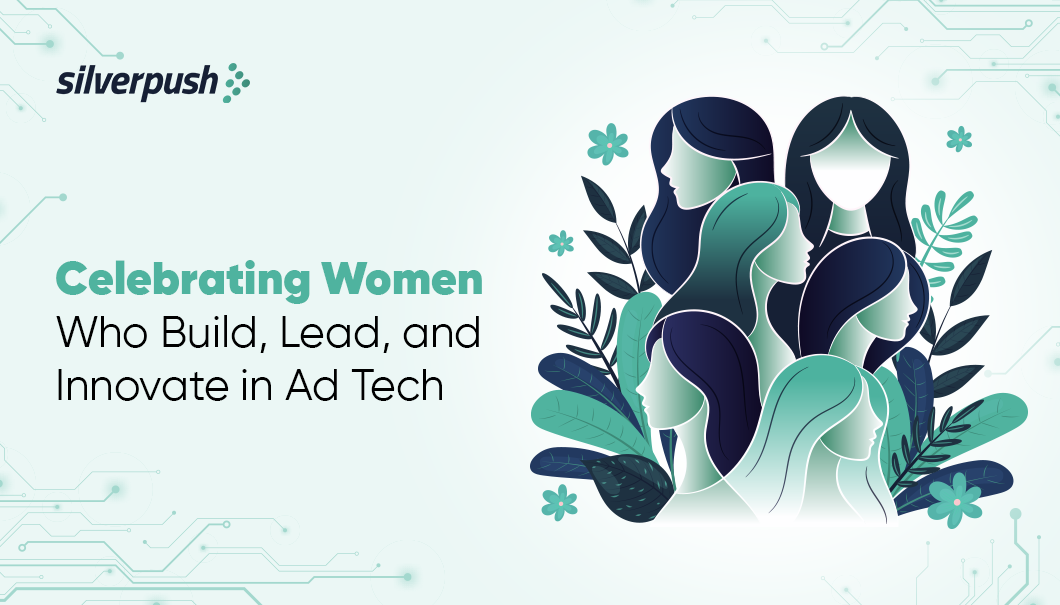
The advertising and tech industries have long been fast-paced, competitive, and constantly evolving, but now they’re also becoming more inclusive than ever. And that’s largely thanks to women who are breaking barriers, challenging norms, and leading innovation in spaces that were once dominated by men.
This International Women’s Day 2025, Silverpush is celebrating the incredible women who are shaping the future of adtech—one idea, one breakthrough, and one bold step at a time.
We sat down with some of our women leaders about their experiences, insights, and advice for the next generation of women in adtech. Here’s what they had to say about it.
Diversity Drives Innovation: How Women Are Changing AdTech
Women are bringing fresh perspectives to the table, and it’s making all the difference.
💡 Sarah Larkin, Senior Director, Branding, shares how having more women in adtech leads to better digital solutions:
“The growing presence of women in adtech continues to drive and foster a profound impact on the development of more inclusive and diverse digital solutions.
Women bring diverse experiences and perspectives that can help create solutions that are more accessible and relevant to a wider audience. This inclusivity ensures that digital solutions meet the needs of a more varied group of people, including underserved or marginalized communities. Women in leadership roles can inspire a culture that ultimately leads to better representation of women and other underrepresented groups across the digital landscape, whether through content, ad creatives, or technological innovation.
Diverse teams are often better equipped to think outside the box by drawing on their individual experiences. Overall, the growing presence of women will help to bring about a more inclusive, fair, and innovative digital world, creating solutions and innovations that will drive a new generation of adtech success.”
From developing AI-powered advertising tools to shaping brand strategies, women are leading the charge in innovation and making sure technology serves everyone—not just the loudest voices in the room.
Empowering Inclusion: The Role of Women Leaders
Great leadership isn’t just about climbing the ladder; it’s about lifting others up along the way.
💡 Wasinee Chongmeesuk, Country Director, Thailand, highlights how women leaders encourage inclusion and empowerment:
“As we celebrate International Women’s Day 2025, it’s clear that female leaders do more than shape the future; they nurture it with empathy, strength, and inclusivity. At Silverpush, I’ve seen how our women leaders lead by example, challenge norms, and create opportunities that drive real change. True empowerment goes beyond individual success; it’s about mentoring, promoting diverse talent, and ensuring AI-driven innovation reflects the world we serve. When we uplift others, we don’t just build careers—we build a more inclusive and forward-thinking industry.”
The Next Generation: Young Women Driving Change in AdTech
Today’s young women are not just participating in the industry but shaping its future.
💡 Jayshree Arora, Sales Director, UK, talks about how brands can tap into this energy:
“To tap into this energy for positive change, brands should focus on being real, sustainable, and inclusive. It’s about promoting products that align with values like social responsibility and eco-consciousness and partnering with influencers and creators who truly live by these ideals. Getting young people involved in the creative process and offering education on sustainability can help build real connections and long-term loyalty. At the end of the day, it’s all about listening to this generation, giving them a seat at the table, and creating campaigns that inspire change while staying true to what matters most to them.”
It’s no longer about just selling a product; it’s about aligning with values that matter. And young women are leading the charge.
What Does Inclusivity Really Mean?
For many women, inclusivity isn’t just a corporate buzzword; it’s a lived experience.
💡 Karishma Gupta, Senior Sales Director, North India, shares her take:
“To me, inclusivity means creating a space where women feel empowered every day. It’s about fostering an environment that offers equal growth opportunities, a voice in decision-making, and supportive policies that prioritize mental well-being while guiding us in maintaining a healthy work-life balance.”
In a world where work-life balance is still a challenge, having women at the forefront of leadership means creating workplaces that work for women, not just expect them to fit into outdated molds.
Final Thoughts
The rise of women in adtech isn’t just a moment—it’s a movement. More than ever, women are:
- Driving innovation in AI, ad targeting, and digital marketing.
- Making workplaces more inclusive with better policies and leadership.
- Creating advertising that reflects real people—not just outdated stereotypes.
- And the best part? This is just the beginning.
So, as we celebrate International Women’s Day 2025, let’s keep the momentum going. Let’s champion diversity, lift each other up, and build an industry where every woman’s voice is heard.
Because when women rise, the whole industry wins.
Why Advertisers Can’t Ignore YouTube Shorts in 2025
PUBLISH DATE: 14 February 2025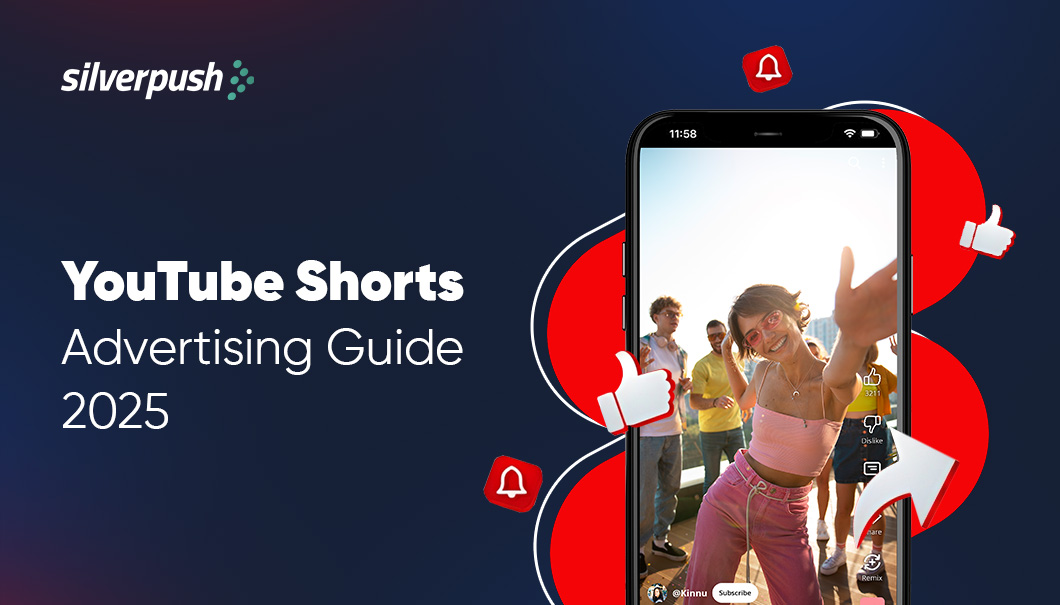
Are you running ads on YouTube Shorts? If not, you might be missing out.
Right now, 43% of U.S. advertisers are already tapping into this fast-growing platform. In Europe, YouTube Shorts ranks as the #1 short-form platform for discovering new brands and products.
If you’re already advertising on YouTube, it’s time to ask yourself—how do Shorts ads fit into your media plan?
The audience is there. The engagement is high. All you need is a smart strategy.
Here’s why YouTube Shorts is becoming a must-have ad channel in 2025.
The YouTube Shorts Landscape
YouTube Shorts is changing the way people consume content. Short-form videos are fast, immersive, and designed to keep viewers hooked. That means more opportunities for brands to capture attention, but only if they understand how to make the most of this space.
So, what makes YouTube Shorts such a big deal for advertisers?
1. A Massive and Fast-Growing Audience
YouTube Shorts is blowing up. More than 2 billion people watch Shorts every month, racking up a mind-blowing 70 billion views per day. Since launching in 2020, the platform has hit 5 trillion total views—and it’s only getting bigger.
So, why the sudden surge? Simple: people can watch Shorts anywhere on their phones, laptops, and even TVs. On connected TV (CTV) alone, viewership has doubled in the last year. Unlike other short-form platforms that are mobile-first, YT Shorts is omnichannel by default, giving brands a bigger, more flexible way to reach audiences.
That means more eyeballs, more engagement, and more opportunities to connect—all without being stuck on just one screen.
2. Higher Engagement Than TikTok & Instagram Reels
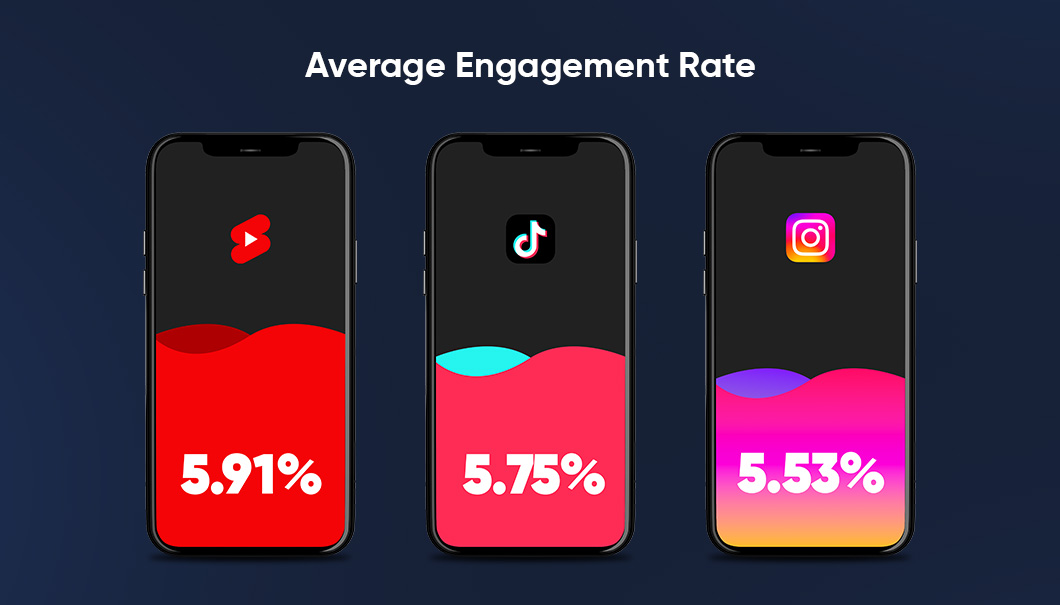
When it comes to engagement, YouTube Shorts is winning. With an average engagement rate of 5.91%, it outperforms TikTok (5.75%) and Instagram Reels (5.53%)—and that’s not by chance.
YouTube’s powerful search and discovery system and multi-device reach keep users watching longer. That means more chances for your brand to connect with the right audience at the right time.
With a smart contextual advertising strategy, you can get your YT short ads in front of highly engaged viewers who are already tuned in and ready to act.
3. YouTube Shorts is Budget-Friendly
Cost per view (CPV) on YouTube Shorts advertising is way cheaper than traditional YouTube ads. That means you can reach more people for less, but only if your ad grabs attention fast.
YouTube Shorts is a swipe-first platform; users are in discovery mode, moving quickly from one video to the next. If your ad is relevant at the moment, you can drive engagement without blowing your budget.
Silverpush data shows that while VTR is often lower for YT Shorts, the reach is nearly 50% higher than standard YouTube videos.
So, the bottom line is context is everything. The right ad, at the right moment, makes all the difference
How Advertising Works on YouTube Shorts
If you’re used to running video ads on YouTube, you’ll notice that Shorts works a little differently—and that comes with its own set of challenges. At Silverpush, we’ve tested and optimized ads for YouTube Shorts, and here’s what we’ve found:
1. There’s no way to target Shorts-exclusive videos
If you’re trying to run ads exclusively on YouTube Shorts, here’s the deal—you can’t. Unlike pre-roll or mid-roll YouTube ads, you can’t directly buy Shorts inventory.
Instead, Shorts ads are bundled into broader campaigns, meaning your budget might end up covering placements across other YouTube surfaces too. So if your goal is to target users actively watching short-form content, you don’t have full control over where your ads appear.
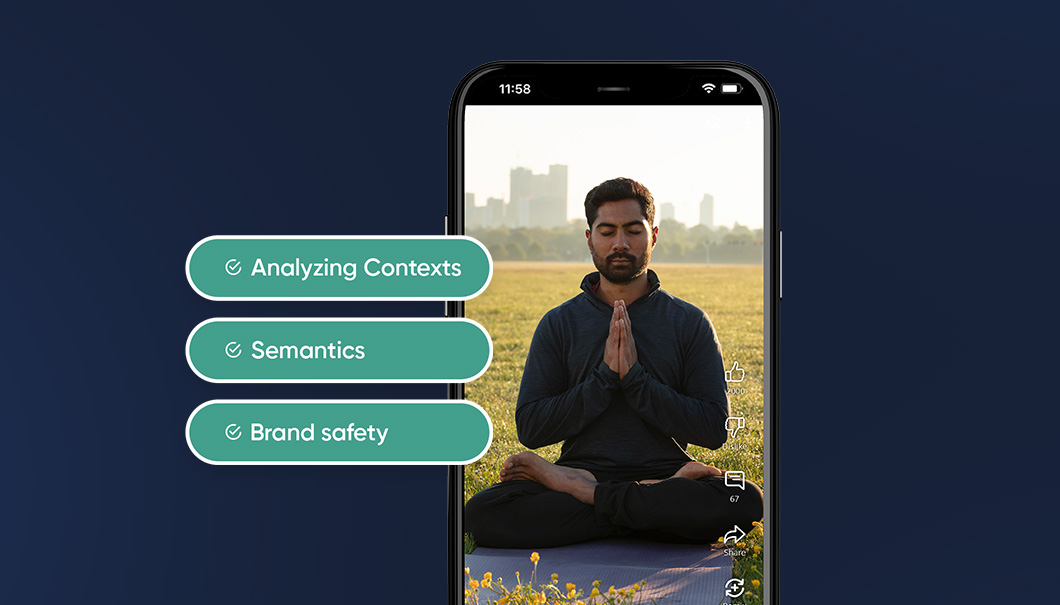
2. Brand Safety in a Scrolling Environment
YouTube Shorts, like all short-form video platforms, is built to keep people scrolling. But that non-stop feed comes with a catch; you don’t control what’s coming next.
One second, your ad is in a great spot. A few swipes later? It could be next to something completely irrelevant or even unsafe. Since videos fly by so fast, there’s no way to predict what’s showing up in the same session. Without the right targeting strategy, your brand’s message could land in the wrong place.
3. Measurement for Multi-Placement Media
Since Shorts ads are bundled into multi-placement campaigns, it’s tough to pinpoint exactly which channel is driving the best results.
And here’s the thing—impressions and engagement work differently in short-form videos. Viewers scroll fast, skip often, and see less, making it harder to gauge real impact. So if Shorts are part of your media mix, you’ll need a better measurement approach to truly understand what’s working.
Why Contextual AI Matters for YouTube Shorts
Short-form content moves fast, and so should your ads. Instead of relying on broad demographics or keywords, what if your ads could appear in the right videos at the right time when viewers are most engaged?
That’s exactly what Silverpush’s Mirrors AI-driven contextual intelligence does. By analyzing YouTube’s content ecosystem in real-time, we help you place ads where they actually make sense. Now, with our award-winning AI engine built for YouTube Shorts, brands and agencies can target based on context, not just interests or search terms.

When Mirrors AI powers your YouTube Shorts advertising strategy, you get more than just better placement; you get better engagement, less wasted spending, and higher ROI.
With contextual AI, you’re in full control of where your ads appear. You can create custom inclusion and exclusion lists to keep your ads aligned with the right content while avoiding anything that doesn’t fit your brand.
Unlike traditional targeting, context-first advertising goes deeper. It analyzes industry trends, seasonal insights, and campaign data in real-time—so your ads don’t just show up; they show up where they matter most.
The Shorts and Short of It
People come to YouTube Shorts to be entertained, learn something new, or explore fresh trends. They’re in the moment—your ad should be too.
That’s where contextual AI changes the game. Instead of interrupting, it helps your YT short ad show up where it makes sense—next to content that matches what your audience is thinking, watching, or searching for.
When your ad feels like part of the experience, it’s not just another skip—it’s a real opportunity to connect.
How Brands Can Tap into the March Madness Hype on YouTube
PUBLISH DATE: 12 February 2025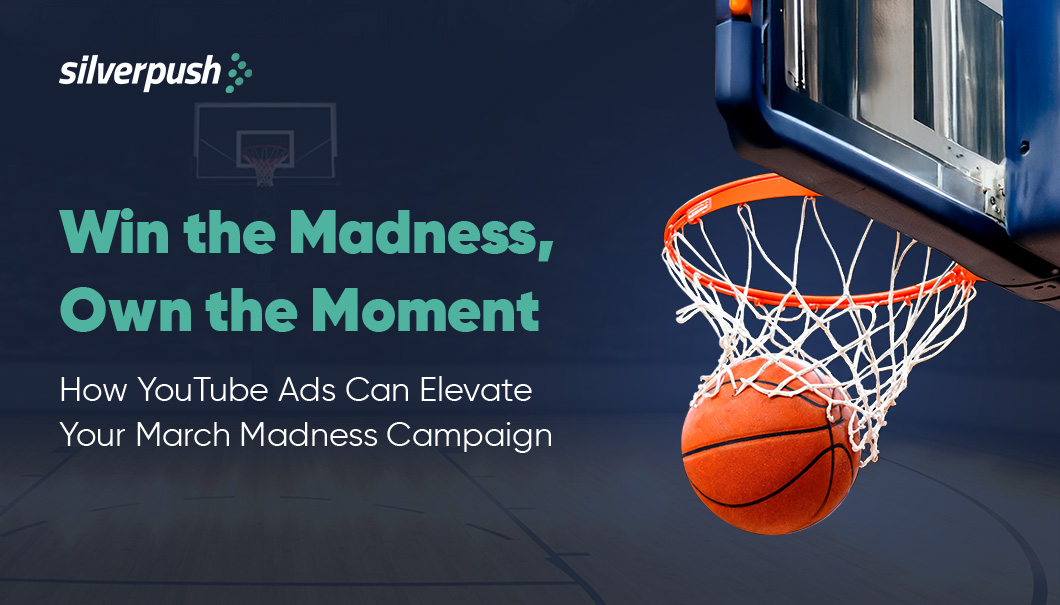
March Madness is more than a basketball tournament; it’s an obsession. From Cinderella stories to last-second buzzer-beaters, it’s the kind of event that turns casual viewers into die-hard fans overnight. But for brands? It’s a once-a-year golden ticket to connect with an audience that’s locked in and emotionally invested.
With 68 teams competing and millions of fans tuning in, the excitement goes far beyond the court. In fact, last year’s National Championship game peaked at 24 million viewers, a jump of 89% from 2023. And here’s the best: fans aren’t only glued to their TVs-they’re coming to YouTube for instant highlights, expert breakdowns, and non-stop analysis.
For brands looking to get in on the action, YouTube is where the real game is. But with competition fiercer than a Final Four showdown, the question is: How do you stand out and make an impact when everyone’s fighting for attention? Let us break it down for you.
March Madness: By the Numbers
The way people watch and experience sports has changed significantly, with YouTube playing an increasing role. Here are some March Madness stats you need to know:
- 52% of viewers aged 18 to 34 prefer to watch March Madness on a streaming service rather than traditional TV.
- Fans are 16x more likely to watch sports-related videos on YouTube during the tournament.
- More than 3 million hours of March Madness content was consumed on YouTube last year.
- In the six months leading up to March Madness 2024, professional basketball-related videos on YouTube averaged over 150 million views per day.
- Sports fans are 13 times more likely to watch coaching/training videos compared to the average YouTube viewer.
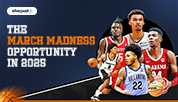
Win the Ad Game This March Madness – Reach Fans Where They Watch!
The Challenges of Reaching March Madness Audiences
With so much focus on the tournament and every brand vying for a piece of the action, March Madness advertising can feel like a packed stadium—crowded, noisy, and overwhelming. Here’s what your brand is up against:
1. Everyone’s competing for attention
March Madness is one of the most sought-after advertising windows of the year. NCAA tournament ads raked in over $1 billion in revenue, with spots selling out before tip-off. Brands must fight for visibility in an already crowded space.
2. Fans aren’t just watching full games
Not every fan watches the full game. Many consume bite-sized content, including recaps, interviews, and sports commentary. Traditional broad-stroke advertising often fails to align with these viewing behaviors.
3. Affinity-based targeting often misfires
Affinity-based targeting and traditional interest-based ads often miss the mark, placing ads in irrelevant content. Misalignment leads to wasted ad spend and low engagement rates.
4. Measuring success isn’t always clear-cut
Understanding which ad placements drive real engagement and adjusting campaigns in real-time is crucial, but many brands lack the right tools to do so effectively.
Smart YouTube Strategies to Win Big This March Madness
With everyone buzzing about March Madness, To stand out, brands need a campaign that balances precision with creativity. With a powerful campaign, casual observers can become active buyers, and therefore, having an ad during such a period can become an ideal chance for conversions and visibility.
Here are five strategies for using YouTube effectively during this NCAA tournament:
1. Contextual Targeting: Be There for the Big Moments
To cut through the noise and reach highly engaged fans, brands need a more strategic, data-driven approach. For the greatest impact, contextual AI-powered targeting is ideal, with ads appearing at the most timely times. In place of generalized interest-based targeting, brands can use contextual analysis to serve ads in key content, such as clips of a game, player interviews, prediction polls, and post-game analysis. With such pinpoint accuracy, brands can target enthusiasts at most engrossed, and ads become an organic part of fan consumption.
2. Make Your Content as Addictive as the Game Itself
Beyond targeting, creating high-value, tournament-branded videos is a breakthrough. Fans don’t necessarily crave ads, but meaningful, branded messaging that extends and enriches their experience. Brands can ride the buzz by creating highlight packages of memorable March Madness moments, player and coach off-court, and interactive experiences such as Q&A and real-time fan feedback. By becoming a part of the conversation seamlessly, brands build deeper relationships and drive recall for the brand.
3. Smart YouTube Ad Placements: Timing Is Everything
Advertising during March Madness is a timely move. Smart brands don’t advertise willy-nilly; they strategically place them before, during, and after games. Anticipatory ads build hype, in-game ad placements bank off high-view times, and post-game promos stretch out conversation. Adding QR codes in ads is a strong mechanism for driving activity, with enthusiasts being in a position to scan and gain access to real-time-only deals, sweeps, and one-time offerings.
4. Team Up with the Right Influencers
Influencer collaborations can stretch out messaging for brands during March Madness as well. With 13 times heightened odds of watching sports training and coaching videos partnering with basketball professionals, influencers, and analysts stretches out an added level of legitimacy and trust. Sponsored posts, prediction articles, and expert analysis resonate with followers actively searching for information. Brands that resonate with dependable sources in the community can gain trust and speak with followers in a less forced voice.
5. Own the Second Screen, Because Fans Can’t Look Away
Lastly, brands can make use of second-screen behavior. 49% of followers use smartphones during gaming, and hence, a tremendous opportunity for coordination between YouTube ads and television moments for the greatest impact can arise. Displaying ads during actual real-time commentary, participating in trending Twitter conversations, and geo-targeting ads at events and sports bars can maximize both reach and engagement even more.
How can Silverpush help your brand?
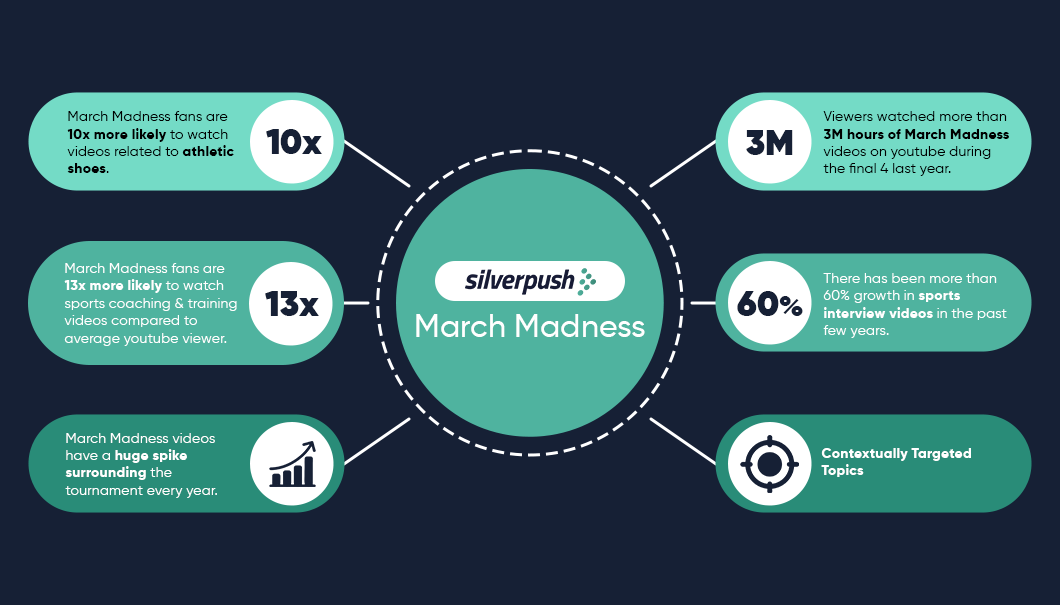
With over 10 years of experience in contextual advertising, Silverpush’s Mirrors AI is transforming March Madness advertising on YouTube. Unlike traditional ad targeting, which often places ads in irrelevant content, Mirrors uses AI to position ads where fans are most engaged—such as in-game highlights and player interviews. This leads to higher engagement, better brand recall, and improved ROI as ads blend seamlessly into content fans love.
March Madness is more than just basketball—it’s a highly interactive cultural phenomenon:-
- 64% of avid fans use YouTube for sports content during the tournament, engaging and making purchases.
- 66% of fans take action after seeing a brand’s sponsorship.
- Forever Fans are 3X more likely to engage with brands aligned with their favorite teams.
- Fans spend an average of $570 on tournament-related purchases, boosting sales for pizza, beer, wings, and desserts. This is an excellent opportunity for FMCG brands to engage with consumers.
By leveraging real-time consumer behavior, Mirrors ensures ads reach the right audience at the right moment. With brand safety, contextual relevance, and intelligent ad placement, it transforms March Madness into a marketing win, maximizing visibility, engagement, and conversions.
Let the Madness Begin! 🚀🏀
Contextual Advertising Guide – Navigating the Cookieless Era
PUBLISH DATE: 29 January 2025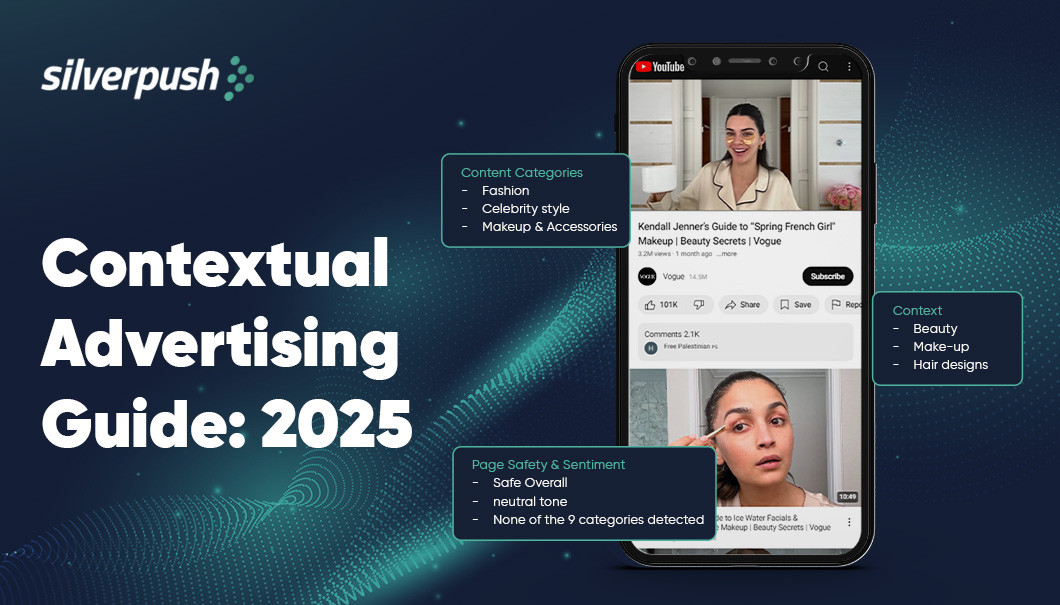
Contextual advertising has been existing in the digital advertising industry for the last 20 years. It was only after the development of user-tracking techniques, that advertisers moved away from this method. However, because of the depreciation of third-party cookies and the rising need for user-data privacy, advertisers have been shifting the focus back to first-party data and the contextual targeting approach.
The Contextual Advertising market has experienced significant growth in recent years and continues to expand rapidly. Valued at $211.62 billion in 2024, it is projected to reach $233.89 billion in 2025, reflecting a robust compound annual growth rate (CAGR) of 10.5%.
In this guide, learn how contextual advertising has become the prime focus for advertisers to drive successful campaigns. The insights mentioned here will not only help you identify how to stand out in a cookieless environment but also understand how to leverage contextual targeting to reach your targeted audience.
Table of Contents
1. What is Contextual Advertising?
2. Benefits of Contextual Advertising
3. Contextual Advertising vs Behavioral Advertising
4. Statistics Highlighting the Importance of Advertising Contextually
5. Examples of Contextual Advertising – Case Study
6. Unveiling Contextual Advertising: A Step-by-Step Breakdown
7. How to Choose the Best-tech Partner for Your Next Advertising Campaign?
8. Introducing Mirrors: Your Best-Tech Partner for Contextual Advertising
9. Conclusion
What is Contextual Advertising?
Contextual advertising is a type of targeted advertising that is served to viewers based on the content or page they are viewing at that moment. For example, if a user is reading a sports article, they might see ads related to sports equipment, or athletic apparel. This approach uses the context of the content to deliver contextually relevant ads, aiming to capture the user’s attention when they are already engaged with a particular topic. By aligning advertisements with the content’s theme or subject matter, contextual advertising seeks to enhance relevance and increase the likelihood of user engagement and conversions.
Benefits of Contextual Advertising
According to a report by Epilson, 69% of advertisers feel that the deprecation of third-party cookies will have much more impact compared to regulations such as GDPR and CCPA. This positions contextual ads as a highly promising alternative to behavioral advertising. The reasons for this include:
1. Reaching the Right Audience at the Right Time: Contextual ad targeting enables advertisers to engage users based on their real-time browsing content, tapping into their immediate interests and intent. This approach ensures reaching users when they are most receptive.
2. Consumer Privacy: Unlike behavioral advertising, contextual advertising stands out by not relying on third-party cookies. By placing ads within relevant content, it respects consumer privacy ensuring that users do not feel like being tracked online.
3. Targeting Specific Audiences: Utilizing topics and keywords, contextual advertising allows advertisers to target niche audiences precisely, catering to their specific interests and preferences.
4. Accessing Real-Time Metrics: Contextual ads empower advertisers to monitor campaign performance in real-time, facilitating timely optimizations for better outcomes and reduced ad spend wastage.
5. Ensuring Brand Safety: Contextual targeting minimizes the risk of ads appearing in inappropriate contexts, safeguarding brand reputation by aligning ads with relevant content and avoiding non-brand-safe environments.
6. Creating Brand Affinity: By serving ads based on the content users are browsing, contextual advertising not only ensures a brand-safe environment but also builds brand affinity, connecting with consumers who resonate with purpose-driven messaging and shared values.
7. No annoying pop-ups: Unlike intrusive pop-up ads, contextual ads blend seamlessly into the webpage, making them less bothersome for users. Since the ads are relevant to the content they’re viewing, people are more likely to engage with them.
Contextual Advertising vs Behavioral Advertising
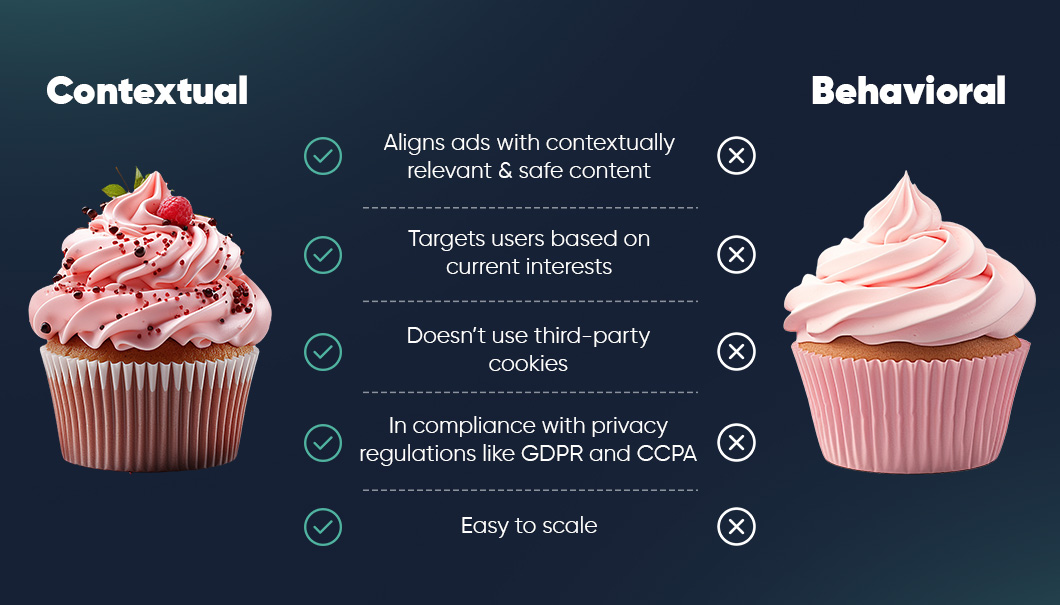
The main difference between contextual & behavioral advertising is that while contextual advertising shows ads based on the web page’s content, behavioral advertising serves up ads based on the user’s past online behavior & browsing history. Behavioral advertising uses consumers’ personal data to serve ads to prospective buyers, whereas contextual advertising places ads in environments that align with users’ interests and do not rely on personal data.
| Behavioral Advertising | Contextual Advertising |
| Utilizes cookies and could potentially be influenced by changing privacy regulations related to cookie usage in web browsers. | Unaffected by Privacy regulations as it does not rely on or gather cookies. |
| Relies on user search history & what sites they spend most time on. | Tailored ads based on the context of a user’s search journey to deliver relevant content. |
| May restrict control over the placement of ads on specific websites. | Advertisements are tailored to both a user’s search queries and their values, ensuring that advertising maintains integrity without compromising reputation. |
| Past behavior might not consistently reflect current relevance. | Contextual ads remain pertinent by aligning with users’ actual search activities. |
Statistics Highlighting the Importance of Advertising Contextually
- The global contextual advertising market is expected to reach $381.82 billion by 2027, growing at a CAGR of 13.3% from 2022 to 2027.
- In 2022, the U.S. was the largest player in the contextual advertising market, with a value of around $65 billion.
- 74% of marketers are using contextual data to improve their advertising post-device ID and post third-party cookies on the web.
- 79% of consumers are more comfortable seeing Contextual than behavioral ads.
- About 80% admitted they were more open to seeing ads that did not require their data.
- 62% of US marketers are using contextual marketing today. (Up from 49% in 2022)
- 42% of brands plan to increase their spending on contextual ads.
- Contextual ads are 50% more likely to be clicked on than non-contextual ads.
- Contextual ads have a 30% higher conversion rate than non-contextual ads.
Examples of Contextual Advertising – Case Study
1. In a recent campaign aimed at building inclusivity and expanding brand reach, Elf Cosmetics incorporated the power of contextual advertising. Traditional targeting methods lead to overgeneralization within ethnic groups. Without proper context and messaging, advertisers may reinforce harmful stereotypes, which can impact brand reputation.
To magnify the impact of the campaign, the company leveraged a hyper-contextual targeting solution – ensuring fair & efficient audience targeting on YouTube, enabling the brand to connect with its most relevant audience in the right context and at the right moment.
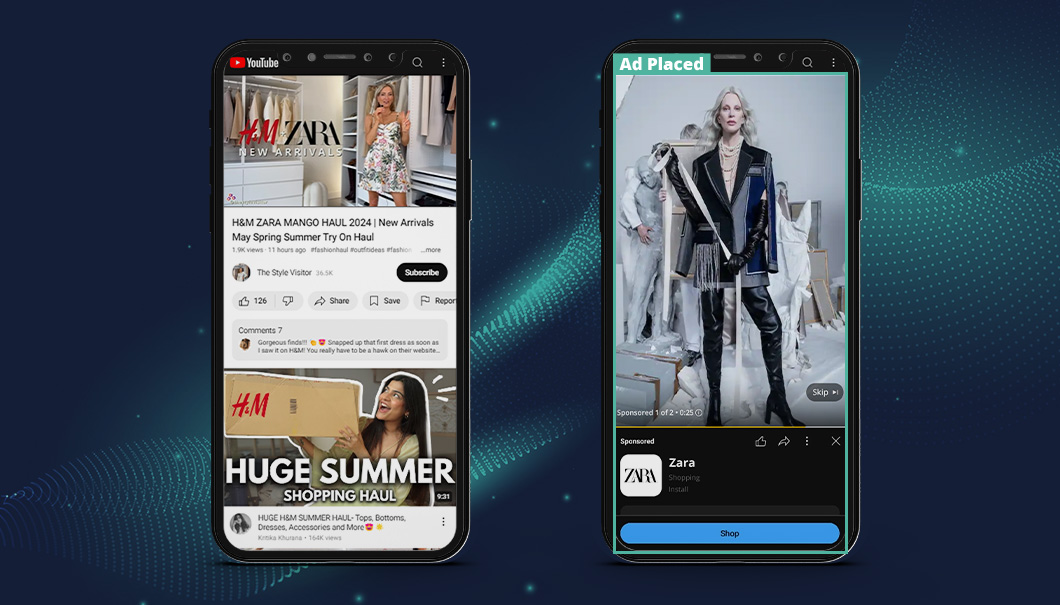
The tech identified key moments like competitor/ community-owned brand mentions, influential figures, applying makeup or skincare, and more. The brand also created an inclusion & exclusion board in adherence to GARM guidelines that did not compromise campaign reach.
Elf cosmetics witnessed a significant uplift in consideration, boasting a remarkable 69% video completion rate on YouTube—1.4 times higher than industry standards. Moreover, the brand experienced explosive search growth, with a staggering 150% YoY increase from January to June, further bolstered by a remarkable 176% surge during the campaign period.
2. Similarly, A UK sports footwear giant identified football as a popular sport to reach the target audience and drive awareness for their new product.
Recognizing the limitations of traditional YouTube targeting based on broad categories and potentially irrelevant placements, the brand adopted a more sophisticated approach. They leveraged a proprietary AI solution designed to identify key contexts within YouTube videos.
The technology specifically targeted Premier League video IDs and identified faces of popular renowned footballers, coaches, commentators, English football club logos, relevant publishers, and broadcasters. This granular targeting strategy significantly expanded the campaign’s reach and ensured ad placements within highly relevant football content, effectively aligning with the target audience’s interests.
The campaign achieved 10 Million+ Impressions and an 87% VTR, 1.08 times higher than the benchmark.
Unveiling Contextual Advertising: A Step-by-Step Breakdown

1. Decoding the Content: Powered by AI
Imagine a smart system equipped with artificial intelligence (AI). This system, called contextual intelligence, acts like a super scanner. It utilizes advanced technologies like computer vision and natural language processing to analyze every detail.
For instance, let’s say you’re browsing a post about a delicious recipe. This wouldn’t just read the text, it would also analyze the accompanying photos. It would be able to recognize the food items and the kitchen utensils pictured. By dissecting all this information, it builds a comprehensive understanding of the content’s theme.
2. Transforming Insights into Actionable Targeting
The technology continues beyond simply understanding the content. It takes that knowledge and translates it into practical applications. This is where the magic of AI comes into play. The platform uses its insights to identify the target audience most likely to be interested in the content.
Going back to our recipe example, the technology might recognize that the reader is interested in cooking. So, it would translate this understanding into actionable targeting.
3. Delivering Context Relevant Ads: Matching User Behavior and Content
Now comes the final step: ad placement. With its deep understanding of both the user’s behavior (reading a recipe) and the content itself (cooking-related), the platform can strategically place relevant advertisements on the web page.
These ads wouldn’t be random. They might be for cooking ingredients, kitchen appliances, or even online grocery delivery services – all directly connected to the user’s current interest in the recipe. In essence, the platform uses contextual intelligence to deliver highly relevant ads that seamlessly blend with the content the user is consuming.
How to Choose the Best-tech Partner for Your Next Advertising Campaign?
While selecting the ideal ad tech partner for an upcoming advertising campaign, it’s crucial to consider questions to ensure their capabilities align with the company’s objectives such as:
- What approach does the ad tech solution take towards targeting?
- Do they offer a comprehensive channel lineup or focus primarily on keyword analysis?
- Can the ad tech solution identify hyper-relevant contexts that are aligned with the campaign goals and objectives?
- Do they employ language detection models to understand slang, dialects, and cultural nuances for accurate context analysis?
- How do they ensure brand safety and suitability within your ad placements?
By seeking answers to these questions, you can gather valuable insights into a potential contextual advertising partner’s capabilities, technology ownership, effectiveness, and credibility, allowing you to make an informed decision when selecting the right partner for your advertising needs.
Introducing Mirrors: Your Best-Tech Partner for Contextual Advertising
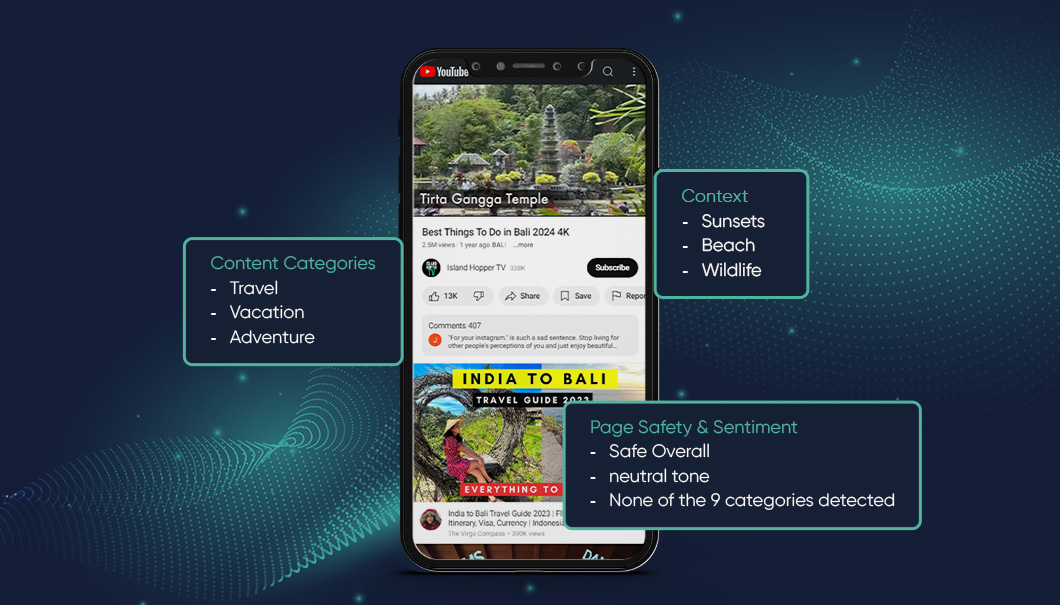
In an era where personalized and relevant advertising matters more than ever, Mirrors empowers brands to move beyond generic targeting. At its core, it leverages advanced AI to analyze the YouTube content ecosystem, going beyond traditional keyword targeting to identify the most contextually relevant moments for your campaigns. This means your ads seamlessly integrate with the content viewers are already engaged with, creating a more meaningful connection that enhances brand recall and audience engagement.
Unlike conventional methods, Mirrors ensures your brand messaging aligns perfectly with the content’s tone and relevance, delivering ads that feel natural rather than intrusive. The proprietary AI doesn’t just focus on relevance; it also prioritizes safety. By automatically excluding unsafe or unsuitable content, Mirrors protects your brand’s reputation and ensures ads appear only in environments that reflect your values.
With precision, transparency, and control at its core, Mirrors ensures your campaigns are activated exactly where they make sense—eliminating inefficiencies and delivering unparalleled results.
Conclusion
As advertisers, navigate the evolving landscape, understanding the details of contextual advertising while using innovative technologies will be the key to unlocking new opportunities for audience engagement and campaign performance. By prioritizing contextual relevance, brand safety, and consumer privacy, advertisers can build stronger connections with their target audience growth in the cookieless era.







